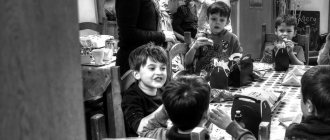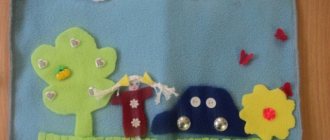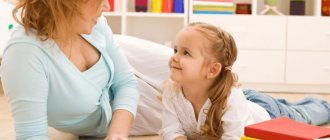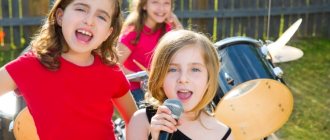Animated dances for children. Video
Animashki! Fun dances with simple movements. Ideal - 3 movements. Sometimes 6, no more. I'm not a choreographer and neither are most people. But we all love to dance! Because it's fun, it energizes us.
Dancing becomes even more interesting if you come up with a plot for it. For example.
Barbariki "Friendship"
I invented this dance myself! Music can be easily downloaded on the Internet, on VK or on any other site.
Introduction to the dance “Friendship” by Barbarika
I ask the children: is it good to be friends? funny? And if a friend feels bad, sad, what can we do for him? The children answer. Me: do you know that all children are a little kind wizards and can perform good miracles?
Let's create a miracle: turn on the sun ! Draw the sun with your hands. The heart clenches all the warmth into fists and now they throw it at their friends (sharply unclenching their hands), to the sides, again. And now they stretched their arms forward. Are your palms warmer? So a miracle happened!
The palms actually become warmer because we caused a rush of blood. But the children believe - it’s a miracle!
Watch the video at the end of the article and everything will become even clearer
The Bears
The song is familiar and loved by more than one generation. Let's get to the plot of the dance . We ask: why does summer and winter, day and night change? Why is this happening? Children explain that the earth rotates... And who spins it? do not know? I'll tell you: polar bears move the earth. But for some reason they were sad, and that’s why our weather is strange. let's help them
And we dance. Then the music is repeated with acceleration several times
If you need a photogram cut, I will send it to you for free. Contact me.
What attracts the bird
A good lead-in to the dance is to ask: do you know animals? What about the birds? And the fish? Show them to me. Now let's make it the same. We show moves and dance.
What to do on the verses? Before this dance, I usually introduce the children to the ribbon and teach them to walk in a looping step. When it works out, we start doing it cool, important, and it’s easier to say show off . (usually laughter here)
And in the song we perform movements at the chorus, and at the verses we show off - we walk in a circle with this meandering step, but with a show off.
Flash mob for children with movements
This is a more modern name for animation dances, dances with repetition of movements. Adults are actively involved in the children's flash mob. This is a great way to have a birthday party with virtually no props.
Flash mobs (animations, game dances) can easily be implemented into any scenario and will replace many competitions at a children's party, or diversify them. Especially if the children are active.
At a kindergarten or school graduation, or for a large group of children, animations are simply a lifesaver! Dancing brings joy to even kids and they repeat the movements with pleasure. This is very nice!
Junior group. Dancing with leaves
Kids with leaves. Dance for children of primary preschool age to the composition “Oak leaves, maple leaves.” Performed by Lyayla Khismatullina.
Swing over me, My golden leaf. Oak leaves, maple leaves.
We are sitting behind a leaf, looking from behind a leaf. Oak leaves, maple leaves.
Suddenly a cheerful breeze wants to tear out my leaf. Oak leaves, maple leaves.
We won’t give you the leaflet, it will be useful to us ourselves. Oak leaves, maple leaves!
Preparatory group. Dance "Falling Leaves".
The older the children, the more complex the movements and dances. The preparatory group dances to the song “It’s not easy to rain today.” Author - N. Naydenova, arrangement - Alexander Zorin, vocals - Marina Melnik.
Today the rain is not simple, today the rain is golden! He is not aquatic at all, there is not a single cloud.
Leaf fall, leaf fall! Leaves are spinning, flying, Leaves are flying in the wind, Falling leaves!
Autumn day is so good, How many leaves can you collect! Golden large bouquet - Greetings from autumn to us!
Leaf fall, leaf fall! Leaves are spinning, flying, Leaves are flying in the wind, Falling leaves!
How to conduct a dance class in kindergarten
In order for children to be able to easily and naturally respond to music by repeating movements, they need to develop the necessary skills and show them how to move their arms and legs correctly. Movements in exercises, games, and dances should be simple. We are talking about walking, running, jumping, jumping, bending, straightening, turning.
Note! When working with children on rhythmic exercises, the teacher must ensure precise execution of movements and ensure correct posture. Violation of the latter affects not only appearance, but also health: incorrect body position leads to curvature of the spine, which makes it difficult for the heart to function.
How to conduct a dance lesson for children in the garden
What exercises are practiced in dance classes at preschool educational institutions?
Any dance lesson in a playful form captivates the child and gives the opportunity for independent activity. In these games, the most important thing is how the child feels when he starts dancing. He discovers a new world in which he can express himself.
Note! A correctly selected song not only determines the emotional character of the images, but also dictates the rhythm, the nature of the performance, the logic of development and change of emotions.
Technology of activity teaching method
Musical-spatial exercises
This includes walking, running, galloping, and jumping. They are usually performed to the accompaniment of a musical instrument, such as a piano.
Stomping step on the entire foot
The teacher asks everyone to take their seats in the carriages. You will have to get to the forest by train:
Chug-chug, puff, puff, grumble,
I don’t want to stand still (the children must stomp),
Sit down quickly, I'll pump you up!
Types of dance movements for preschoolers
In practice, the following types of dance movements for preschoolers are most often used.
Body staging
The “tree” with its crown stretches upward towards the sun.
Walking
A simple step in different tempo and rhythm:
Calm - let's walk,
Clear - let's march,
Soft (like a fox, a cat) - we quietly make our way.
Run
Slow, light in a row (leaves or snowflakes have flown, little mice are running, peas have scattered).
Walking and running combined
Soft step and small run - (cat - mouse).
Heavy step and small run - (bears - mice).
Techniques for dance classes in kindergarten
The quality of children's movements largely depends on the starting position. The correct starting position organizes children externally and internally and mobilizes their attention.
- Walking. In rhythmic classes, the following types of walking are used: from the toes, on the toes, with a roll from heel to toe, stomping step, springy, wide, with high lifting of the legs.
- Run. The position of the body when running should accompany fast movement: the body should be slightly tilted forward, without straining the shoulders; Relax your hands. By running you can create a certain artistic image.
- Jumping develops the muscles of the legs, abdomen and entire torso, strengthens the ligaments and joints of the legs.
Important! In rhythmic exercises performed in accordance with the nature of the music, the task of maintaining balance is associated with the musical mode.
Middle group. Dance with rowan
Girls of the middle group dance with a sprig of rowan. Song “There is a shadow on the path”, lyrics by Elena Blagina.
On the path there is shadow-shadow-shadow, Solar net. Through the tyn, through the fence, a branch bent.
I’ll come running, I’ll gallop, I’ll stand up on my toes! I’ll grab the branch by the braid and get the berries!
Chorus: Berries, berries, rowan berries. Berries, berries, rowan berries.
I’ll sit by the fence, and carefully string a rowan berry onto the silk.
Put on your bitter beads, become smart, branch! On the path there is shadow-shadow-shadow, Solar net.
Why hold dances for kids?
In preschool age, the foundations of a healthy lifestyle, harmonious, mental, moral, physical and aesthetic development of the child are laid. Dance art is a world of beauty, movements, sounds, colors of light, costumes.
Dancing for babies with repetitive movements
During dance classes with repetitive movements, children develop auditory, visual, and muscle memory, and learn noble manners. The student learns the variety of dance: classical, folk, modern, etc.
For your information! Dance art fosters sociability, hard work, the ability to achieve goals, and forms an emotional culture of communication.
General tasks of musical education of preschool children
The teacher pursues certain goals of musical education of preschool children. Among them are:
- educational, which introduce children to the art of dance, expand knowledge about this activity, develop skills in basic movements, the ability to listen to music, understand its mood and character. The main task of the teacher is to develop a sense of rhythm, tempo, coordination and freedom of movement;
- educational tasks are aimed at developing activity, independence, and communication abilities.
Dance classes in the preschool educational system
Dancing for children to repeat movements is carried out in stages with the aim of mastering the basic basics of rhythm, the ABCs of classical, Russian and modern dances. To do this, create a program that determines:
- stages of development of skills in a child, which become more complex each time;
- the process of mental development of the baby;
- group learning of the lesson.
The influence of movements on child development
Dance movements affect both the mental and mental development of the child. During physical exercise and physical activity, the synthesis of biological active elements in the body accelerates. This helps to improve sleep, increase mental and physical performance. A preschooler attending kindergarten can:
- take part in classes;
- analyze the information received;
- explore the world around you;
- feel confident;
- reveal your talent.
The main movements that influence overall development are throwing, grasping, jumping, grasping, throwing and catching, for example, a ball. Games with rattles and balls affect the baby’s psyche and motor skills.
For your information! The first grasping reaction appears at 4-5 months.
The influence of rhythm and movement
Good coordination of movements is important for any child. Thus, the baby will learn to control his body. Good coordination is a guarantee of the safety of a child who will not fall and will be able to dodge his peers.
The sense of rhythm is an innate phenomenon that cannot be corrected. Many children, hearing their favorite melody, begin to dance, making conscious movements. The sense of rhythm should be developed from an early age. It is advisable to do this in a playful way.
Making crafts according to traffic rules in kindergarten with your own hands
The influence of rhythm and repetition
The teacher should pay attention to the child’s musicality. His ability to reflect the characteristics of music in a playful form plays a huge role. Children need to be gradually introduced to music that conveys diverse images. Melodies should be chosen cheerful, lyrical, gentle, energetic, strong-willed.
Note! You can choose the following children's fun songs for dancing with movements: “The Nutcracker”, The Wolf and Little Red Riding Hood, a song from “Sleeping Beauty”, Coppelius dolls from “Coppelia”, “The Horse Game” from “A Vain Precaution”. These are just some of the samples that can be taken to accompany choreographic classes.
Senior group. Entrance to the matinee with leaves
The guys in the older group dance to the song “Dance with Autumn.” Song author Tatyana Petrova, arrangement Alexander Zorin, performer Alina Afanasova.
Look at the leaf - it’s burning like a lantern. The leaf wants to dance - He flies in the dance with us!
We put the foot on the toe and knock everything with the heel. We will add smooth gestures, And then we will spin.
The Beauty Queen invited us to dance. She gave me a leaf, traces of autumn everywhere...
Autumn in polka circles with us, Sings a song merrily. Today we will all become friends with our autumn round dance.
Middle group. Golden Day invites us
Children stand in 2 or 3 rows towards the auditorium. In the hands are leaves of isolon.
The golden day invites us, invites us to take a walk. A golden day offers us an offer to play.
CHORUS: Look like little lights, Lights-lights, Our multi-colored leaves, Our leaves-leaves.
We are like forest butterflies, flying through a clearing. The wings are painted leaves, and they are not afraid of the rain.
Can we shield ourselves from the rain with our little leaf? We can’t rush home - Under a leaf, like under an umbrella.
The breeze plays with us - All the leaves rustle, merrily change places and fly, fly, fly.





